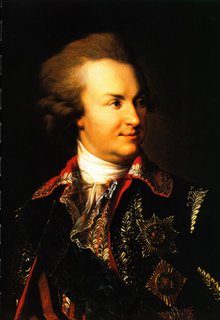Grigori Alexandrovich Potemkin
|
|
Knyaz Grigori Alexandrovich Potyomkin (Potemkin) (Russian: Григо́рий Алекса́ндрович Потёмкин) (September 131739 (NS: September 24) – October 5 1791 (NS: October 16)) was a Russian general-field marshal, statesman, and favorite of Catherine II the Great. He is primarily remembered for his efforts to colonize the sparcely populated wild steppes of Southern Ukraine, which passed to Russia under the Treaty of Kuchuk-Kainarji (1774). Among the towns founded by Potemkin are Kherson, Nikolaev (Mykolayiv), Sevastopol, and Yekaterinoslav (now Dnipropetrovsk).
| Contents |
Early life
He was born in Chizhovo village near Smolensk into the family of a minor army officer. After studying at the University of Moscow, he enlisted in the horse guards. He participated in the palace coup in 1762 which ousted Peter III and enthroned Catherine II. He received the rank of second lieutenant of the Guards. Catherine needed reliable assistants and appreciated Potemkin's energy and organizational abilities. The biographical anecdotes relating to him during the next few years, such as his participation in the assassination of the deposed emperor, are obscure and mostly apocryphal.
Catherine II's lover
In 1774, their relationship took on a more intimate character. Potemkin became a favorite of the tsarina; he received a lot of awards, and was given the highest posts. During the next 17 years he was the most powerful person in Russia. Potemkin found pleasure in ostentatious luxury and personal wealth. Like Catherine he gave in to the temptation of absolute power; however in many dealings he was guided by the spirit of Enlightenment. He showed tolerance of religious differences, and gave protection to national minorities. As commander-in-chief of the Russian army (nominally from 1784) he emphasized a more humane concept of discipline, demanding that officers take care of soldiers in a paternal way.
In 1776, at Catherine's request, the Emperor Joseph II raised Potemkin to the rank of a prince of the Holy Roman Empire. In 1775 he was superseded in the empress's graces by Zavadovsky; but the relations between Catherine and her former lover continued to be most friendly, and his influence with her was never seriously disturbed by any of her subsequent favorites. A whole mass of facts testify to the enormous and extraordinary influence of Potemkin during the next ten years. His correspondence with the empress was uninterrupted. The most important state documents passed through his hands.
Governing of Novorossiya
Ukraine_Cherson_2St.-Ekater.jpg
Potemkin achieved appreciable success in Russia's newly won southern provinces, in which he was an absolute ruler. He supported a stream of both Russian and foreign colonists, he founded some new cities, and created the Black Sea Fleet. In 1783 he carried out the project of annexing Crimea to Russia, for which he received the title of His Serene Highness Knyaz Tavrichesky (Светлейший князь Таврический), or prince of Tauride, after an ancient name for Crimea. Four years later he organized Catherine's widely advertised ceremonial travel with her retinues to the southern provinces. The purpose of the trip was the intimidation of Russia's enemies, and it led to a war for which the country appeared poorly prepared (Russo-Turkish War, 1787-1792). As commander, Potemkin was guided by a cautious strategy that was militarily justified but did not win him popularity.
His colonizing system was exposed to very severe criticism, yet it is impossible not to admire the results of his stupendous activity. The arsenal of Kherson, begun in 1778, the harbour of Sevastopol and the new fleet of fifteen liners and twenty-five smaller vessels, were monuments of his genius. But there was exaggeration in all he attempted. He spared neither men, money, nor himself in attempting to carry out his gigantic scheme for the colonization of the south Ukrainian steppes; but he never calculated the cost, and more than three-quarters of the design had to be abandoned when but half finished.
In 1790 he conducted the military operations on the Dniester and held his court at Jassy with more than Asiatic pomp. In 1791 he returned to St Petersburg where, along with his friend Bezborodko, he made vain efforts to overthrow the new favourite, Prince Zubov, and in four months spent 850,000 roubles in banquets and entertainments at the Tauride Palace, a sum subsequently reimbursed to him from the treasury. Then the empress grew impatient and compelled him (1791) to return to Jassy to conduct the peace negotiations as chief Russian plenipotentiary. On October 5, 1791, while on his way to Nikolayev, he died in the open steppe, 40 miles from Jassy, in consequence of eating a whole goose while in a high state of fever. His death occassioned Derzhavin's great ode Waterfall.
Assessment
Very various are the estimates of Potemkin. Neither during his life nor after his death did any two people agree about him. The German pamphlet, published in 1794, is a fair specimen of the opinion of those who regarded him as the evil genius of Catherine and of Russia. But there were many, including the empress herself, who looked upon him as a man of manifold and commanding genius. He was indubitably the most extraordinary of all the Catherinian favorites. He was an able administrator, but wanting in self-control. Licentiousness, extravagance and an utter disregard for human life were his weak points, but he was loyal, generous and magnanimous. Nearly all the anecdotes related of him by Helbig, in the biography contributed by him to the journal Minerva (1797-1800), and freely utilized by later biographers, are absolutely worthless.
References
- Official site of the Tauride Palace (http://www.iacis.ru/)
- Russian biography (http://www.krugosvet.ru/articles/36/1003600/1003600a1.htm)
See also
de:Grigori Alexandrowitsch Potjomkin he:גרגורי_אלכסנדרוביץ_פוטיומקין lb:Grigori Alexandrowitsch Potjomkin

